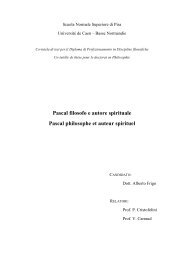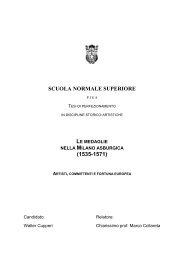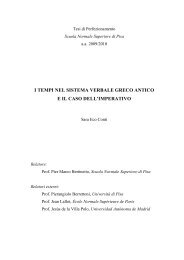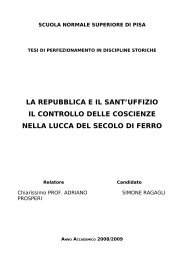CATULLUS 68 - Scuola Normale Superiore
CATULLUS 68 - Scuola Normale Superiore
CATULLUS 68 - Scuola Normale Superiore
You also want an ePaper? Increase the reach of your titles
YUMPU automatically turns print PDFs into web optimized ePapers that Google loves.
straightforward Yes or No. In short, the text fails to clarify a number of clear issues. This needs to be<br />
explained. How is it possible that the reader is left in the dark about matters of such vital importance?<br />
Catullus’ poem <strong>68</strong>a is, like several other poems of his, a letter in verse. 92 To be more precise, it is a reply to a<br />
letter from the addressee. In that letter Manlius had described the misfortunes that had overcome him and<br />
had asked the poet for help. This means that if we had Manlius’ letter as well as Catullus’ reply to it, we<br />
would know perfectly well what was Manlius’ problem, what he asked from Catullus, and whether or not<br />
lines 27-29 of this poem contained a verbatim quotation from his letter. 93<br />
That letter is now lost, but it was certainly read by two people, Manlius and Catullus. It is easy, then, to<br />
answer our question why poem <strong>68</strong>a is so extraordinarily obscure: it is a real letter, that is, it was written in<br />
order to be sent to its addressee and to communicate a given message to him; and since it was intended in the<br />
92 Other unambiguous cases of letters in verse in the Catullan corpus are carmen 35, where the papyrus is addressed<br />
(35.2 uelim Caecilio, papyre, dicas) and carmen 65, which is a note accompanying some translations of Callimachus<br />
(65.15f. mitto / haec expressa tibi carmina Battiadae – and note that haec carmina implies several translations: Catullus<br />
does not use the poetic plural). Some other poems of Catullus’ may well be considered as letters in verse because they<br />
convey an ephemeral message to their addressee: such are carmina 9 and 50 (messages to friends who have spent time<br />
with Catullus but gone home), 13 (a dinner invitation), 14 (an instantaneous reply to a friend who has sent a humorous<br />
gift) and 116 (a note to a friend who has been asking the poet to send him some translations, like 65 and, mutatis<br />
mutandis, <strong>68</strong>a). One could compare with these an epigram by Catullus’ friend Cinna (frg. 11 FPL) is a note that once<br />
accompanied a gift of a luxury edition of Aratus sent by the poet to its anonymous addressee. In fact, Catullus<br />
addresses a contemporary in a majority of his poems, a part of which could also be considered as letters in verse, but<br />
here one should practise caution: some of these poems will hardly have been sent as letters, because they are highly<br />
offensive and/or addressed to celebrities (e.g. 21, 23, 25, 29, 47, 49, 54, 86 and 93); and in other poems Catullus<br />
addresses a place (17, 31, 37 and 44), an animal (2), an object (4 and 36) and even himself (8 and 46). Catullus<br />
evidently detaches the device of the address from its real-life context of letters and conversations and uses it in new<br />
ways that are made possible by the fiction that his poems speak to all.<br />
93 Hartman 1915: 92 maintains the opposite: “responsum ad Manlii epistolam certum de rebus certis quas ex ipso<br />
responso tam bene cognoscimus ut epistola illa – licet periisse eam vehementer doleamus – opus non sit.” But this is<br />
surely a wild (note “vehementer”) exaggeration: the controversy about how poem <strong>68</strong>a should be interpreted was well on<br />
its way by this time, even though Hartman maintains that there is an interpretation that is manifestly correct.<br />
45






